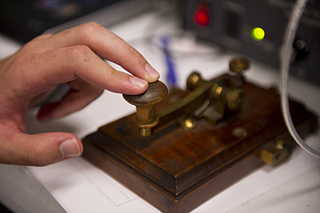Thousands of amateur (ham) radio operators around the world were able to say “Hi” to NASA’s Juno spacecraft Oct. 9 as it swung past Earth on its way to Jupiter.
According to Donald Kirchner, University of Iowa research engineer on Juno and one of the coordinators of the all-volunteer “Say Hi to Juno” project, all licensed amateur radio operators were invited to participate by visiting a website and following posted instructions.
“The idea was to coordinate the efforts of amateur radio operators all over the world, and send a message in Morse code that could be received by the University of Iowa-designed-and-built instrument on the Juno spacecraft,” he says. “We know that over a thousand participated, and probably many more than that.”

Interestingly, Juno did not return the greeting or even decode the message itself. Rather, after the amateur radio operators’ messages were sent, the Juno team evaluated the Waves instrument data containing the messages after the Oct. 9 flyby. The message was visible early in the event when the spacecraft was still over 37,000 kilometers—about 23,000 miles—from the Earth.
Kirchner notes that although previous space missions—Galileo on its way to Jupiter and Cassini while headed for Saturn—were able to detect shortwave radio transmissions during their Earth encounters, it was not possible to decode intelligent information using the data from those spacecraft.
According to Bill Kurth, UI research scientist and lead investigator for the Waves instrument: “We believe this was the first intelligent information to be transmitted to a passing interplanetary space instrument, as simple as the message may seem,” he says. “This was a way to involve a large number of people—those not usually associated with Juno—in a small portion of the mission. This raises awareness, and we've already heard from some that they'll be motivated to follow the Juno mission through its science phase at Jupiter.”
Kurth is scheduled to participate in a press conference on the scientific information gathered during Juno's Earth fly-by, as well as the success of the "Say Hi to Juno" project, at 10:30 a.m. (PST) or 12:30 p.m. (CST) today, Tuesday, Dec. 10 during the Fall Meeting of the American Geophysical Union in San Francisco.
Kirchner says that the project originated when public outreach staff at NASA’s Jet Propulsion Laboratory in Pasadena, Calif., wanted to know if the UI receiver was able to pick up a voice message. Although that isn’t possible, Kurth and Kirchner came up with the idea that a slow Morse code message should work.
Kirchner is an amateur radio operator, himself, and took the lead in designing the project. His usual ham activities include being an assistant emergency coordinator with the Johnson County Amateur Radio Emergency Service, which works closely with the Johnson County Emergency Management Agency to provide backup and auxiliary communications.
To make the transmission to Juno, he enlisted a student organization, the UI Amateur Radio Club, to set up a temporary station on the roof of Van Allen Hall. Operating for a few days up to the flyby, he and other club members contacted hundreds of stations in 40 states and 17 countries to raise awareness of the project.
The “say Hi” project was made possible by the fact that Juno passed within 350 miles of the Earth’s surface on Oct. 9 in a maneuver to gain momentum for its July 2016 encounter with Jupiter.
Plans call for Juno to orbit Jupiter 33 times. Among a variety of investigations, Juno will explore Jupiter's northern and southern lights by flying directly through the electrical current systems that generate them.
The Waves instrument was built at the UI by a group of about a dozen scientists, engineers, and technicians, led by Kurth and Kirchner. Terry Averkamp, Chris Piker, and William Robinson, also an amateur radio operator, assist in the operation of the Waves instrument and in the data processing. UI researchers are Kurth and colleagues UI professor Don Gurnett and research scientist George Hospodarsky.
The Juno project is a collaborative enterprise led by Scott Bolton, of the Southwest Research Institute of San Antonio, including the UI and many other organizations and individuals.
NASA's Jet Propulsion Laboratory (JPL), Pasadena, Calif., manages the Juno mission for the principal investigator, Bolton. The Juno mission is part of the New Frontiers Program managed by NASA's Marshall Space Flight Center in Huntsville, Ala. Lockheed Martin Space Systems, Denver, built and operates the spacecraft. Launch management for the mission was the responsibility of NASA's Launch Services Program at the Kennedy Space Center in Florida. JPL is a division of the California Institute of Technology in Pasadena.
For more information, see this NASA website or this Mission Juno website.